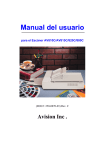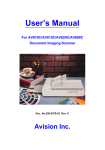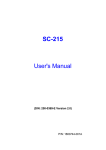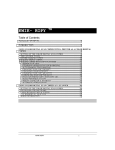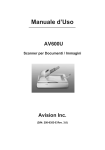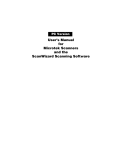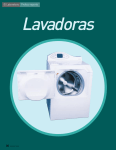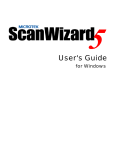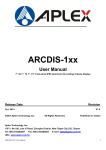Download Avision AV100CS User`s manual
Transcript
AV100CS Color Image Scanner User's Manual Version 2.0 (Doc. No. 250-0072-E) AVISION INC. 1997 Trademarks Microsoft is a U.S. registered trademark of Microsoft Corporation. Windows and MS-DOS are trademarks of Microsoft Corporation. IBM, PC, AT, XT are registered trademarks of International Business Machines Corp. Other brands and product names herein are trademarks or registered trademarks of their respective holders. Copyright All rights reserved. No part of this publication may be reproduced, transmitted, transcribed, stored in a retrieval system, or translated into any language or computer language, in any form or by any means, electronic, mechanical, magnetic, optical, chemical, manual, or otherwise, without the prior written permission of Avision Inc. Material scanned by this product may be protected by governmental laws and other regulations, such as copyright laws, the customer is solely responsible for complying with all such laws and regulations. ii Warranty The information contained in this document is subject to change without notice. Avision makes no warranty of any kind with regard to this material, including, but not limited to, the implied warranties of fitness for a particular purpose. Avision shall not be liable for errors contained herein or for incidental or consequential damages in connection with the furnishing, performance, or use of this material. iii FCC Radio Frequency Interference Statement This equipment has been tested and found to comply with the limits for a class B digital device, pursuant to Part 15 of the FCC rules. These limits are designed to provide reasonable protection against harmful interference in a residential installation. This equipment generates, uses, and can radiate radio frequency energy and, if not installed and used in accordance with the instruction manual, may cause harmful interference to radio communication. However, there is no guarantee that interference will not occur in a particular installation. If this equipment does cause harmful interference to radio or television reception, which can be determined by turning the equipment off and on, the user is encouraged to try to correct the interference by one or more of the following measures: * Reorient or relocate the receiving antenna. * Increase the separation between the equipment and receiver. * Connect the equipment into an outlet on a circuit different from that to which the receiver is connected. * Consult the dealer or an experienced radio/TV technician for help. CAUTION: Any changes or modifications not expressly approved by the manufacture of this device could void the user's authority to operate the equipment. iv Table of Contents 1. INTRODUCTION.............................................................................. 1-1 2. SCANNER INSTALLATION............................................................ 2-1 2.1 INSTALLATION PROCEDURE.............................................................. 2-1 2.2 INSTALLATION OF THE SCSI CARD ................................................... 2-6 2.3 CONNECTING THE CABLE ................................................................. 2-8 2.4 SETTING THE SCSI ID ................................................................... 2-10 3. SCANNER DRIVER INSTALLATION ............................................ 3-1 3.1 MAC USERS ................................................................................... 3-1 3.2 PC USERS ....................................................................................... 3-5 4. OPERATING THE SCANNER......................................................... 4-1 4.1 MAC USERS ................................................................................... 4-1 4.2 PC USERS ....................................................................................... 4-2 4.3 IMAGE TYPE .................................................................................... 4-5 4.4 RESOLUTION CONTROL .................................................................... 4-7 4.5 IMAGE CONTROL ............................................................................. 4-8 4.6 SCANNING..................................................................................... 4-11 5. MAINTENANCE ............................................................................... 5-1 5.1 CLEANING THE ADF........................................................................ 5-1 5.2 CLEANING THE CALIBRATION BOARD ............................................... 5-3 6. TROUBLESHOOTING..................................................................... 6-1 6.1 QUESTIONS AND ANSWERS............................................................... 6-2 6.2 TECHNICAL SERVICE........................................................................ 6-4 7. SPECIFICATIONS ............................................................................ 7-1 7.1 MODEL: AV100CS ......................................................................... 7-2 v 1. Introduction Congratulations on your purchase of the AV100CS color sheet-fed image scanner. Avision Inc. is one of the leading companies in the world to develop high performance sheetfed scanners. Before you install and operate the new scanner, please take a few minutes to read through this manual. It provides proper instructions for you to unpack, install, operate and maintain the scanner. Figure 1-1 shows how the scanner is packed. Please check all the items against your checklist. If you do not receive all the items, please contact your authorized local dealer immediately. 1-1 Figure 1-1 Scanner packing 1-2 2. Scanner Installation Precautions * Keep the scanner out of direct sunlight. Direct exposure to the sun or excessive heat may cause damage to the unit. * Do not install the scanner in a humid or dusty place. * Be sure to use the proper AC power source. * Place the scanner securely on an even, flat surface. Tilted or uneven surfaces may cause mechanical or paper-feeding problems. * Retain the scanner box and packing materials for shipping purposes. 2.1 Installation Procedure Please unpack the packing carefully, and check the contents against the checklist. If any items are missing or damaged, please contact your dealer immediately. Installation of the slide guides, the paper guide and the paper stand. (See Fig. 2-1) 1. Open the scanner front door by pulling it away from the unit gently. 2. Insert the paper guide into the center notch located on top of the unit. 3. Insert the two slide guides to the left and right of the paper guide. When properly installed, the guides should move freely from side to side. 4. Insert the two ends of the paper stand into the small holes on both sides of the paper guide. 5. Close the scanner front door. 2-1 Figure 2-1 Install the slide guides, the paper guide and the paper stand. Document loading Standard paper size should feed easily through the scanner. To avoid occasional paper jam when automatically feeding multiple documents, loosen the paper before loading. (Figure 2-2) 2-2 Figure 2-2 Loosen the paper before loading. 2-3 Document feeding Insert the document to be scanned face down in the scanner. Align the two sides of the document with the slide guides. (Figure 2-3) Figure 2-3 Place documents in the ADF. 2-4 Scanning small documents To scan small documents, such as business cards, exchange the positions of the two slide guides, adjust the distance in between so that it suits the size of the document, and hand feed the document. (Figure 2-4) 1. Open the scanner front door. 2. Remove the two slide guides. Exchange their positions and reinsert them with the left guide going now to the right and the right now to the left. 3. Close the scanner front door. Figure 2-4 Exchange the positions of the two slide guides. 2-5 2.2 Installation of the SCSI Card Hardware Installation Power off your computer. Plug the SCSI card in an available slot of your computer. Be sure to screw it firmly. Power on your computer. Software Installation In Windows 3.1 If your SCSI card is bundled with Avision AV100CS, then installing the scanner driver will at the same time complete the installation of the SCSI card driver. If your SCSI card is not bundled with Avision AV100CS, then please follow the installation sheet contained in your SCSI card. In Windows 95 Press Start Setting Control Panel. And then double click "Add New Hardware". Select SCSI Adapter. Choose Have disk and type "d:\DTCSCSI"(d representing the letter for your current CD-ROM drive) Choose Finish and restart Windows 95. In Windows NT Press Start Setting Control Panel. And then double click "Add New Hardware". Select SCSI Adapter. Choose Driver tag and Add new SCSI Adapter. Choose Have disk and type "d:\DTCSCSI(d representing the letter for your current CD-ROM drive) Choose Finish and restart Windows NT. • If your SCSI card is bundled with Avision AV100CS, you can refer to the Appendix for more details in regards to the installation of the SCSI driver. 2-6 • If your SCSI card is not bundled with Avision AV100CS, then you can refer to the installation sheet contained in your SCSI card or ask for details from your SCSI card vendor. 2-7 2.3 Connecting the Cable Make sure the power of scanner is off. Connecting the SCSI cable to the scanner The AV100CS scanner is provided with an active terminator already. As such, if the scanner is the only (or final) SCSI device connected to your host computer, turn the active terminator to the on position, and the scanner will function all right. Do not attach an additional passive terminator to the connection! If the scanner is linked in a SCSI chain (between the host computer and other devices), turn the active terminator to the off position, plug the SCSI cable from other devices into the unused SCSI connector of the scanner, and add a passive terminator to the last device of the SCSI chain (See Figure 2-6). 2-8 Connect the power cable and signal cable as shown below: Figure 2-5 AV100CS scanner cable connection Figure 2-6 SCSI chain configuration Figure 2-6 In the SCSI chain configuration, the scanner is connected to the host computer; a second SCSI cable then connects the scanner with other devices. 2-9 2.4 Setting the SCSI ID SCSI ID: If you have several devices on a SCSI chain, you may need to adjust the SCSI ID selector which is located on the back panel of the scanner. This action is to make sure each device match with a unique SCSI ID number. If the ID# you select is duplicate with an existing SCSI device, then please select a different ID#. (See Figure 2-6) Note: The default SCSI ID number for Avision AV100CS is 6. Usually ID# 0 is assigned to an internal hard disk drive, and ID# 7, to SCSI adapter or host. Figure 2-6 Adjust the SCSI ID setting 2-10 3. Scanner Driver Installation 3.1 MAC Users The AV100CS scanner must have the following minimum requirements to run at rated speed as recommended: * MAC II series; Quadra series, Perfoma series; Power Macintosh series or later recommended; * At least 20 M Bytes of free hard disk space; * A minimum of 8 M Bytes of system memory required; 16 M Bytes or higher recommended; * Mac compatible display card and monitor with at least 256 colors; thousands colors or million colors display card recommended; * System 7 or later. The installation procedures of Avision scanner driver are as follows: 1. 2. 3. 4. 5. It is highly recommended that to close the anti-virus program and exit all other applications currently running. Install on your computer the image-editing or scannerrelated application you want to use with the scanner, such as OmniPage, PhotoShop, etc. Insert “Avision PaperCom Supreme ” into your disk drive. Open Avision Driver Kit icon. The Avision Driver Kit 3.X.X as Fig. 3-1 will appear. Read "Read Me First" for notice or information which you should be aware of. Double click on the ”AV Kit 3.X.X Installer” icon. AV Kit 3.X.X Installer window will appear as Fig. 3-2. Click Easy Install icon and drag it to system in the right side. A dialog box as Fig. 3-3 appears. Select name of your application (as PhotoShop...) for plug in. Choose Plug in. 3-1 7. The installation will be completed. Choose Restart to proceed your next step. If you want to use applications such as OmniPage, Xerox TextBridge, Type Reader, etc., you have to setup the ISIS driver to access the scanner. The ISIS driver is a file named vision Scan.” To setup, select Chooser command from the menu. A dialog box as Figure 3-4 will appear on Apple the screen. Select the vision Scan” icon, ignore the scanner Model” list and the et SCSI ID” button, the diver will automatically find your scanner model and SCSI ID. You can then start your application to use the scanner, see your application reference manual for more details. Figure 3-1 Avision Driver Kit 3.X.X 3-2 Figure 3-2 AV Kit 3.X.X Installer Figure 3-3 Select a folder for plug-in 3-3 Figure 3-2 Chooser 3-4 3.2 PC Users To run at rated speed as recommended, the AV100CS color scanner must have the following minimum requirements: * IBM compatible PC 386/486 or Pentium; * Microsoft Windows 3.1, Windows 95, or Windows NT; * DOS 5.0 or higher; * One SCSI card installed one your computer; * 20 megabytes of available hard disk space for installation; * 8 megabytes of RAM (16 megabytes or higher recommended); * A video graphics array (VGA) monitor; * A Microsoft Windows-compatible pointing device (e.g., the mouse); * A CD-ROM drive. Installation procedures of Avision Scanner driver with Avision Auto-installation Program are as follows: 1. Start Windows 3.1 or Windows 95. 2. Insert Avision PaperCom Supreme CD to your CD-ROM drive. For Windows 3.1 or Windows 3.11 From the File Menu, choose RUN. Type d:\Driver\AV100CS.exe (d means the letter indicating your current CD-ROM drive). Choose O.K. For Windows 95 3. Press the Start button and choose RUN. Type d:\Driver\AV100CS.exe (d represents the letter for your current your CD-ROM drive). Choose O.K. 3-5 4. Follow the subsequent instruction on the screen to complete the instruction. (Normally just press OK and the installation will be completed.) For Windows NT From the File Menu, choose RUN. Type d:\Driver\AV100CS.exe (d represents the letter for your current your CD-ROM drive). Choose O.K. 3-6 4. Operating the Scanner 4.1 MAC Users Start your application. From File menu, choose Acquire command. Select MrScan-Expert from the submenu of Acquire. The Mac Plug-in user interface as Figure 4-1 will pop up on the screen. Place the document upside down on the document board(glass) with the text facing away from you. Click on the Preview or Scan button to preview or scan your document or image. Figure 4-1 The Mac Plug-in user interface 4-1 4.2 PC Users Open your application and choose Select Source from the File menu. If the Select Source command is not available from the File menu, see the user guide of your application to learn how the TWAIN link is used. A dialog box appears containing the different TWAIN sources for you to choose from to bring an image into your application. Select MrScan-Expert as the source. You need to select MrScan-Expert for just once except when you need to use the dialog box to select a different source. In that case, you will need to select MrScan-Expert as the source again before you can reuse the AV100CS scanner. Place the document upside down on the document board with the text facing away from you. From the File menu, choose Acquire. Avision TWAIN user interface as Figure 4-2 will pop up on the screen. Click Preview or Scan button to scan the document. 4-2 Figure 4-2 Avision TWAIN user interface 4-3 Scanning Source: AV100CS scans two types of source, the document as well as the transparency. Select either one from the screen of Avision TWAIN user interface for your own purpose. Please see Figure Figrue 4-3 as shown below. Figure 4-3 Scanning Source 4-4 4.3 Image Type Select image type through the mode from the screen of Avision TWAIN user interface for your own purpose. Please see Figure 4-4 as below: Figure 4-4 Image Type Mode 4-5 Each image type is described as follows: Line art Line art includes only black and white areas. There are no intermediate shades of gray in between. Halftone Halftone simulates different shades of gray by varying the threshold value of a matrix. Gray (256 levels of gray scale) Scanner recognizes each point in the image as a shade of gray (continuous tone). 8-bit gray gives more detailed information about the image. True Color (16.7 million colors) Color image have continuous tones along with its color hues. 256 Colors The 256 colors image provides 256 levels of color hues. 4-6 4.4 Resolution Control A good control of the resolution results a satisfactory detail of an image that scans. The resolution is measured by dots per inch(dpi). Normally, the greater the dpi number, the higher the resolution and the image file size. Be aware that the greater resolution takes more time, memory and disk space, therefore, up to a certain degree of dpi, the resolution will not visually be improved, on the contrary, it makes your files more unmanageable. Figure 4-5 Resolution Control 4-7 4.5 Image Control Brightness: Adjusts the lightness or darkness of an image. The higher the value, the brighter the image. Contrast: Adjusts the range between the darkest and the lightest shades in the image. The higher the contrast, the bigger the different gray scales. Gamma: Adjusts the midtone of the image without losing details of the lightest and the darkest areas. Highlight: Adjusts the highlight area of the image. Shadow: Adjusts the darkest area of the image. Auto Level Automatically adjusts the highlight and shadow areas of the scanned image to give it an optimal effect. 4-8 Invert: The invert command reverses the brightness and the color in the image. For color images, each pixel will be changed into its complementary color at the command of Invert. Color Match: Adjusts the color quality of the image so that it comes close to that of the original. This function uses default parameters to adjust the image. Sharpen: Descreen: Sharpens the scanned image. selections under this item. Look for more Eliminates the moire patterns commonly found in printed matter. 4-9 Before Descreen After Descreen 4-10 4.6 Scanning Preview: Scan: Exit: Previews your image to allocate the area to be scanned. Scans the area with the parameters you have set. Cancels the current job. As shown in the figure below, in the Preview window, you can define the area to be scanned by dragging the cursor auxiliary lines with the mouse. 4-11 5. Maintenance 5.1 Cleaning the ADF Your scanner is designed to be maintenance free. However, it still needs to be occasionally to ensure optimum image quality and performance. The scanner parts may be contaminated with ink, toner particles or paper coatings. As a result, the scanner will need to be cleaned frequently in case: 1) Documents do not feed smoothly or easily; 2) Several documents feed at the same time. The cleaning procedures (See Figure 5-1) 1) Soak a cotton swab with some isopropyl alcohol. (95%). 2) Open the scanner front door and wipe the upper feeding roller by moving the swab from side to side. Rotate the roller forward with your finger and repeat the cleaning steps above until the entire roller is cleaned. Be careful not to damage the pick springs. 3) Wipe the pad in one direction from top to bottom or the other way around. Be careful not to damage the pick springs. 4) Close the scanner front door. Your scanner is now ready for use. 5-1 Figure 5-1 Open the scanner front door. 5-2 5.2 Cleaning the Calibration Board As shown below in Figure 5-2, clean the calibration board with an air-blower or a small brush to rid the board of dust or dirt. Please handle with care and dexterity. 1. Calibration Board 2. Scanner Front Door Figure 5-2 Clean the calibration board. 5-3 6. Troubleshooting The scanner will automatically perform a simple self test each time when it is powered on. This will help spot major system errors in the scanner itself. If you have any problem with the operation of the scanner, please check the following troubleshooting hints. 6-1 6.1 Questions and Answers Question: Paper becomes jammed during scanning. Answer: 1) Open the scanner front door. 2) Pull out the jammed paper carefully. 3) Close the scanner front door. Question: More than one sheet of paper are fed into the scanner. Answer: 1) Open the scanner front door. 2) Remove the multi-fed sheets of paper. 3) Close the scanner front door. 4) Flatten the corners and edges. Loosen the paper before putting it into the paper guide again. 5) Check the feeding roller condition. If necessary, follow the cleaning directions in section 5.1 and perform the cleaning. Question: Paper becomes skewed in the scanner. Answer: 1) Use the slide guide to keep the paper path straight. 2) Check the condition of the feeding roller. If necessary, follow the cleaning directions in Section 5.1 and perform the cleaning. 6-2 Question: Why is it my scanned image always comes out too dark? Answer: 1) Modify the Gamma setting to 1.8 for your monitor and, when printing, set Gamma to 2.2 for your printer. 2) Use the Brightness setting of the TWAIN user interface to get a brighter image. Question: Sometimes it seems the scanner does not detect paper? Answer: The AV100CS scanner paper sensor is located at the center of the paper guide. Please place the document you need to scan on the paper guide and use the slide guides to keep the paper path straight. Question: To get image from the scanner is no problem. But when scanning, the scanner or the system will often crash. Answer: 1) Please check that the cable is firmly seated. 2) Only two SCSI terminators can be connected to your SCSI daisy chain. One is at the end of the SCSI device, the other already in your host adapter. (Please see Section 2-3 for more details.) 6-3 6.2 Technical Service Technical support for Avision scanner is provided at the Avision Technical Assistance Center (ATAC). Before contact with ATAC, please prepare the following information: * Scanner serial & revision number (located on the bottom of the scanner); * Hardware configuration (e.g., your host CPU type, RAM size, free disk space, display card, interface card...); * The name and version of your scanning software application; * The version of your scanner driver. Please call us at: US and Canada Area: Avision Labs., Inc. Address :6094 Stewart Avenue, Fremont, CA 94538 USA Telephone number :510-440-8785 Fax number :510-440-8337 Web Site :http://www.avision.com E-mail :[email protected] Other Area: Avision Inc. Address :No.20, Creation Road I, Science-Based Industrial Park, Hsinchu, Taiwan, R.O.C. Telephone number :886-3-5782388 Fax number :886-3-5777017 Web Site :http://www.avision.com Email :[email protected] 6-4 Note: 1. You can find the latest driver and documents in Avision Web. Our service is 24 hours a day. 6-5 7. Specifications All specifications are subject to change without notice. The following can not be properly fed by ADF: * Paper with clip or staple attached; * Paper with ink not totally dry; * Paper with inconsistent thickness, such as envelopes; * Paper with wrinkles, curls, folds or tears; * Tracing paper; * Coated paper; * Carbonless paper; * Paper narrower than 3.5" or wider than 8.5"; * Items other than papers, such as cloth, metal or OHP film; * Notched paper; * Paper with an odd (non-rectangular) shape; * Very thin paper. 7-1 7.1 Model: AV100CS Scanner Type: Optical Resolution: Maximum Resolution Scanning Modes: Document Feed: ADF Capacity: Scanning Speed (100 dpi, letter size) Document Size Min. Document Size: Paper: Interface: Power Source: Power Consumption: Dimensions: (WxHxD) Weight: EM1 Safety Desktop sheet-fed 300 dpi * 600 dpi 9600 dpi * 9600 dpi Black & White mode Halftone mode (64-step) Error Diffusion 8-bit gray scale (256 levels) 24-bit color (16.7 Millions of color) Auto Document Feeder (ADF) Up to 10 pages Color Gray Line art 10 sec 9 sec 9 sec Letter, legal, A4, B5, A5, business card 4" x 3.5" (ADF) 3.5" x 2" (manual feed) 16 lbs. to 24 lbs. SCSI 110Vac ~ 220Vac, 50-60Hz, external 12 watts (12Vdc,1A) 293 mm x 89 mm x 107 mm 3.5 lbs. FCC Class B, CE UL, CUL 7-2 EC Declaration of Conformity According to EN45014 Manufacturer's Name: Manufacturer's Address: AVISION INC. No. 20, Creation Road I, Science-Based Industrial Park, Hsinchu, Taiwan, R.O.C. declare that the product Model Number : AV100CS conforms to the following Product Specifications: Emission: EN 50081-1 (1992) EN 55022 (Class B) (Conducted Radiated) (1994) EN 60555-2 (Harmonics) (1987) EN 60555-3 (Flicker) (1987) Immunity: EN50082-1 (1992) IEC 1000-4-2 (ESD) (1995) IEC 1000-4-3 (RS) (1995) IEC 1000-4-4 (EFT/Burst) (1995) IEC 1000-4-5 (SURGE) (1995) Date: October, 1996 7-3 Appendix Detailed Procedure for installing SCSI Driver In Windows 95, please: The "New Hardware Found?" dialog box will be displayed. Choose Driver from hard disk provided by the hardware manufacturer or choose Do not install a driver. If you choose Driver from hard disk provided by the hardware manufacturer, please follow the following procedure. The "Install from hard disk provided by the hardware manufacturer" dialog box will be displayed. Press Browse button to assign your path. Type d:\DTCSCSI (d is the letter indicating your current CD-ROM drive). Press OK. The unknown device statement will be displayed. Press OK. The d:\SCSI and filename will be displayed. Press OK. Your are now completing the installation of SCSI card on your computer. If you choose Do not install a driver, please follow the following procedure. 1) Click Windows Start icon from the bottom. Choose Setting. Choose Control Panel from Setting. 2) Double click "Add new hardware" icon from the Control Panel. The "Add new hardware wizard" dialog box will be displayed. Choose Next. 3) The "Do you want Windows to search for your hardware" dialog box will be displayed. Press No and then press Next. 7-4 4) 5) 6) 7) Choose hardware type "SCSI Controller", then press Next. The "click the manufacturer & model of your hardware" dialog box will be displayed. Choose current SCSI manufacturer and model and then press Next. Follow the subsequent procedure as indicated to complete the installation and to restart Windows 95. If current manufacturer and model are not listed in the selection box, press Have disk button. The "Have disk" dialog box will be displayed. Type d:\DTCSCSI in the path box(d is the letter indicating your current CD-ROM drive). Choose Confirm and follow the subsequent procedure as indicated on the screen to complete the installation.. The "Finish" dialog box will be displayed. Choose Finish and then choose Restart the Windows 95. In Windows 3.1, please: 1) If your SCSI card is bundled with Avision AV100CS, then installing the scanner driver will at the same time complete the installation of the SCSI card driver. 2) If your SCSI card is not bundled with Avision AV100CS, then please follow the installation sheet contained in your SCSI card. In Windows NT, please: 1) Click Windows Start icon from the bottom. Choose Setting. Choose Control Panel from Setting. 2) Choose SCSI Adapter from the Control Panel. The " SCSI Adapter" dialog box will be displayed. Choose Driver. 3) Choose Add and select manufacturer and SCSI adapter 7-5 4) 5) 6) Choose Have disk if your SCSI card manufacturer and SCSI adapter is not listed in the selection box. Type d:\DTCSCSI and choose Confirm. Follow the subsequent procedure on the screen to complete the installation. When the "System Setting Change" dialog box appears, choose OK to restart Windows NT. 7-6
















































